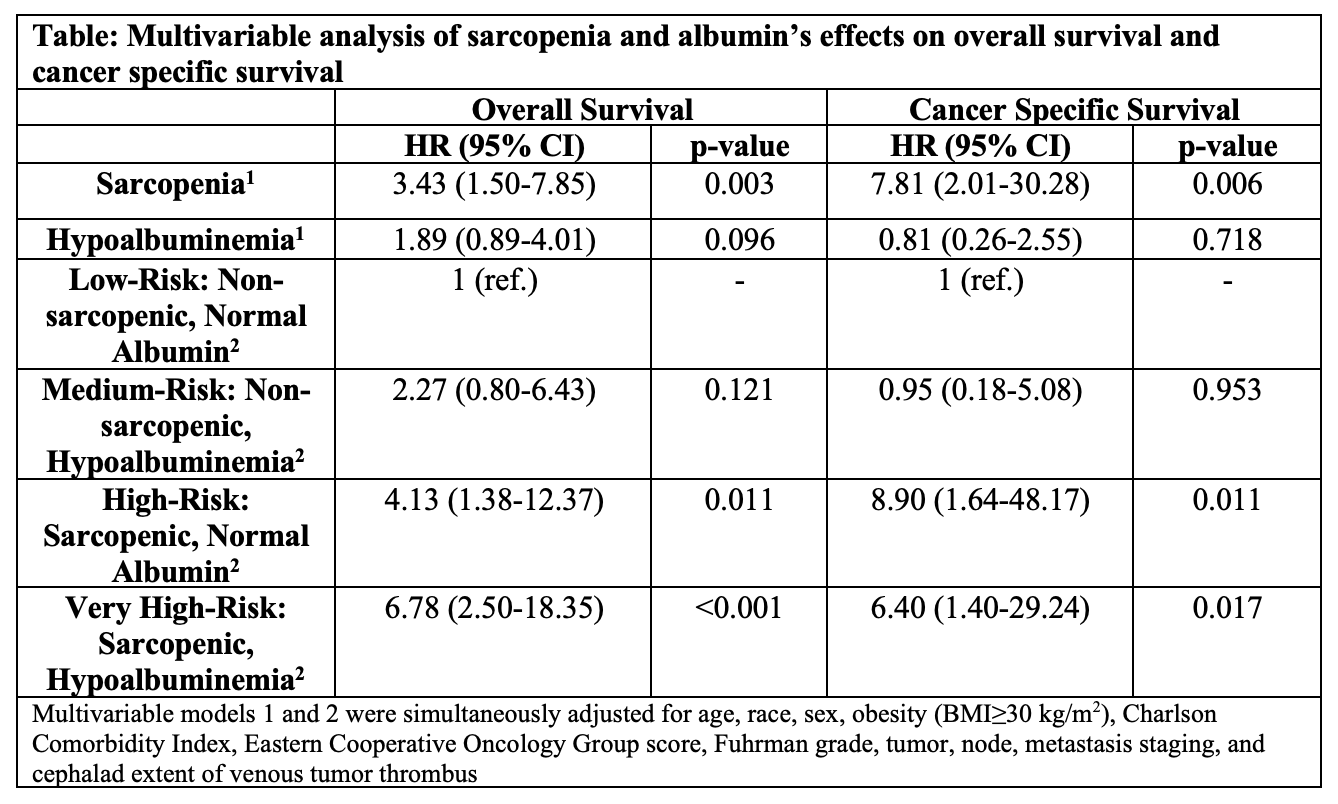Back
Poster, Podium & Video Sessions
Moderated Poster
MP47: Kidney Cancer: Epidemiology & Evaluation/Staging/Surveillance III
MP47-14: The Role of Combined Sarcopenia and Albumin in the Surgical Prognostication of Locally Advanced Renal Cell Carcinoma with Venous Tumor Thrombus
Sunday, May 15, 2022
2:45 PM – 4:00 PM
Location: Room 228
Eric Midenberg*, Dattatraya Patil, Alexandra Medline, Atlanta, GA, Michelle Higgins, Baltimore, MD, Milton Williams, Birmingham, AL, Sarah P. Psutka, Seattle, WA, Kenneth Ogan, Mehmet A. Bilen, Viraj A. Master, Atlanta, GA
- EM
Eric Midenberg, MD, BS
Emory University School of Medicine
Poster Presenter(s)
Introduction: Baseline evaluation of skeletal muscle index (SMI; cm2/m2) and serum albumin have demonstrated value in the preoperative risk assessment of patients with renal cell carcinoma (RCC). We hypothesize that sarcopenia, defined as a critical deficiency in skeletal muscle mass, and hypoalbuminemia will be associated with decreased overall survival (OS) and cancer specific survival (CSS) in nonmetastatic RCC patients undergoing radical nephrectomy and tumor thrombectomy.
Methods: We retrospectively analyzed 103 nonmetastatic RCC patients who underwent radical nephrectomy and tumor thrombectomy from 2005 to 2020. Optimally fit body mass index (BMI; kg/m²) and sex-stratified sarcopenia thresholds were calculated: BMI <30, SMI <47 for males and SMI <38 for females; BMI=30, SMI <54 for males and SMI <47 for females. Sarcopenia and albumin risk groups were created based on their individual hazard ratios in univariable analysis and defined as low-risk (non-sarcopenic, normal albumin), medium-risk (hypoalbuminemia only), high-risk (sarcopenia only), and very high-risk (sarcopenia, hypoalbuminemia). Multivariable and Kaplan-Meier analyses were used to determine associations between independent and combined sarcopenia and hypoalbuminemia (albumin <3.5 g/dL) with OS and CSS.
Results: Preoperatively, 51.2% and 44.7% of our cohort had sarcopenia and hypoalbuminemia, respectively. In the independent multivariable analysis, sarcopenia was significantly associated with decreased OS (p=0.003) and CSS (p=0.006) whereas no relationship between hypoalbuminemia and OS and CSS was found (OS: p=0.096; CSS: p=0.718). In a separate model analyzing the combined sarcopenia and albumin risk groups, the high and very high-risk groups were significantly associated with decreased OS (high-risk: p=0.011; very high-risk: p<0.001) and CSS (high-risk: p=0.011; very high-risk: p=0.017). Kaplan-Meier curves showed a stepwise decline in median OS (p=0.007) and CSS (p=0.007) times with increasing risk.
Conclusions: Simultaneous preoperative sarcopenia and hypoalbuminemia conveyed nearly a seven-fold decrease in OS and CSS in patients undergoing surgery for nonmetastatic RCC with venous tumor thrombus.
Source of Funding: N/A

Methods: We retrospectively analyzed 103 nonmetastatic RCC patients who underwent radical nephrectomy and tumor thrombectomy from 2005 to 2020. Optimally fit body mass index (BMI; kg/m²) and sex-stratified sarcopenia thresholds were calculated: BMI <30, SMI <47 for males and SMI <38 for females; BMI=30, SMI <54 for males and SMI <47 for females. Sarcopenia and albumin risk groups were created based on their individual hazard ratios in univariable analysis and defined as low-risk (non-sarcopenic, normal albumin), medium-risk (hypoalbuminemia only), high-risk (sarcopenia only), and very high-risk (sarcopenia, hypoalbuminemia). Multivariable and Kaplan-Meier analyses were used to determine associations between independent and combined sarcopenia and hypoalbuminemia (albumin <3.5 g/dL) with OS and CSS.
Results: Preoperatively, 51.2% and 44.7% of our cohort had sarcopenia and hypoalbuminemia, respectively. In the independent multivariable analysis, sarcopenia was significantly associated with decreased OS (p=0.003) and CSS (p=0.006) whereas no relationship between hypoalbuminemia and OS and CSS was found (OS: p=0.096; CSS: p=0.718). In a separate model analyzing the combined sarcopenia and albumin risk groups, the high and very high-risk groups were significantly associated with decreased OS (high-risk: p=0.011; very high-risk: p<0.001) and CSS (high-risk: p=0.011; very high-risk: p=0.017). Kaplan-Meier curves showed a stepwise decline in median OS (p=0.007) and CSS (p=0.007) times with increasing risk.
Conclusions: Simultaneous preoperative sarcopenia and hypoalbuminemia conveyed nearly a seven-fold decrease in OS and CSS in patients undergoing surgery for nonmetastatic RCC with venous tumor thrombus.
Source of Funding: N/A


.jpg)
.jpg)